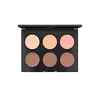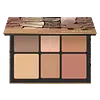Mac Cosmetics Studio Fix Sculpt And Shape Contour Palette Versus Smashbox Cali Contour & Highlighter Face Palette
What's inside
What's inside
 Key Ingredients
Key Ingredients

 Benefits
Benefits

 Concerns
Concerns

 Ingredients Side-by-side
Ingredients Side-by-side

Talc
AbrasiveNylon-12
Octyldodecyl Stearoyl Stearate
EmollientZinc Stearate
Cosmetic ColorantIsostearyl Neopentanoate
EmollientAscorbyl Palmitate
AntioxidantTocopheryl Acetate
AntioxidantHordeum Vulgare Extract
EmollientTriticum Vulgare Germ Extract
Skin ConditioningSqualane
EmollientTin Oxide
AbrasiveCaprylyl Glycol
EmollientMagnesium Myristate
Hexylene Glycol
EmulsifyingPhenoxyethanol
PreservativeMica
Cosmetic ColorantCI 77891
Cosmetic ColorantIron Oxides
CI 75470
Cosmetic ColorantCI 15850
Cosmetic ColorantCI 77007
Cosmetic ColorantCI 19140
Cosmetic ColorantTalc, Nylon-12, Octyldodecyl Stearoyl Stearate, Zinc Stearate, Isostearyl Neopentanoate, Ascorbyl Palmitate, Tocopheryl Acetate, Hordeum Vulgare Extract, Triticum Vulgare Germ Extract, Squalane, Tin Oxide, Caprylyl Glycol, Magnesium Myristate, Hexylene Glycol, Phenoxyethanol, Mica, CI 77891, Iron Oxides, CI 75470, CI 15850, CI 77007, CI 19140
Mica
Cosmetic ColorantOctyldodecyl Stearoyl Stearate
EmollientZinc Stearate
Cosmetic ColorantTocopherol
AntioxidantLauroyl Lysine
Skin ConditioningAscorbyl Palmitate
AntioxidantCamellia Sinensis Leaf Extract
AntimicrobialWater
Skin ConditioningCaprylyl Glycol
EmollientIsopentyldiol
HumectantPhenoxyethanol
PreservativeIron Oxides
CI 77891
Cosmetic ColorantCI 77163
Cosmetic ColorantCI 42090
Cosmetic ColorantCI 75470
Cosmetic ColorantCI 77510
Cosmetic ColorantCI 77742
Cosmetic ColorantCI 15850
Cosmetic ColorantCI 45380
Cosmetic ColorantCI 45410
Cosmetic ColorantCI 73360
Cosmetic ColorantCI 17200
Cosmetic ColorantCI 15880
Cosmetic ColorantCI 12085
Cosmetic ColorantCI 19140
Cosmetic ColorantCI 15985
Cosmetic ColorantCI 77007
Cosmetic ColorantTalc
AbrasivePolyethylene
AbrasivePhenyl Trimethicone
Skin ConditioningNylon-12
Ptfe
CI 77491
Cosmetic ColorantCI 77492
Cosmetic ColorantCI 77499
Cosmetic ColorantCI 77289
Cosmetic ColorantCI 77288
Cosmetic ColorantBoron Nitride
AbsorbentDimethicone
EmollientParaffinum Liquidum
EmollientEthylhexyl Palmitate
EmollientPanthenol
Skin ConditioningTin Oxide
AbrasiveCalcium Sodium Borosilicate
Mica, Octyldodecyl Stearoyl Stearate, Zinc Stearate, Tocopherol, Lauroyl Lysine, Ascorbyl Palmitate, Camellia Sinensis Leaf Extract, Water, Caprylyl Glycol, Isopentyldiol, Phenoxyethanol, Iron Oxides, CI 77891, CI 77163, CI 42090, CI 75470, CI 77510, CI 77742, CI 15850, CI 45380, CI 45410, CI 73360, CI 17200, CI 15880, CI 12085, CI 19140, CI 15985, CI 77007, Talc, Polyethylene, Phenyl Trimethicone, Nylon-12, Ptfe, CI 77491, CI 77492, CI 77499, CI 77289, CI 77288, Boron Nitride, Dimethicone, Paraffinum Liquidum, Ethylhexyl Palmitate, Panthenol, Tin Oxide, Calcium Sodium Borosilicate
Ingredients Explained
These ingredients are found in both products.
Ingredients higher up in an ingredient list are typically present in a larger amount.
Ascorbyl Palmitate is created by combining pure Vitamin C and palmitic acid. It is an antioxidant and helps reduce hyperpigmentation.
This ingredient is a more stable version of Vitamin C, meaning it does not disintegrate as quickly when exposed to sunlight. However, studies show it does not penetrate skin as well as pure Vitamin C.
Ascorbyl Palmitate is oil soluble.
Read more about other types of Vitamin C:
Learn more about Ascorbyl PalmitateCaprylyl Glycol is a humectant and emollient, meaning it attracts and preserves moisture.
It is a common ingredient in many products, especially those designed to hydrate skin. The primary benefits are retaining moisture, skin softening, and promoting a healthy skin barrier.
Though Caprylyl Glycol is an alcohol derived from fatty acids, it is not the kind that can dry out skin.
This ingredient is also used as a preservative to extend the life of products. It has slight antimicrobial properties.
Learn more about Caprylyl GlycolCi 15850 is the pigment color red. It is an azo dye and created synthetically.
Azo dyes need to be thoroughly purified before use. This allows them to be more stable and longer-lasting.
This ingredient is common in foundations, lipsticks, and blushes. This color is described as brown/orangey red.
It has many secondary names such as Red 6 and Red 7. According to a manufacturer, Red 6 usually contains aluminum.
Learn more about CI 15850CI 19140 is also known as Tartrazine. Tartrazine is a synthetic dye used in cosmetics, foods, and medicine to add a yellow color.
Tartrazine is created from petroleum and is water-soluble.
Some people may experience allergies from this dye, especially asthmatics and those with an aspirin intolerance.
Learn more about CI 19140Ci 75470 is a bright-red pigment. It is AKA carmine.
Carmine is derived from insects such as the cochineal beetle. This ingredient has been used as a natural dye for over 2000 years.
This pigment is called Ultramarine blue lazurite. It gives a saturated blue color, but can be used to create other colors as well.
According to the manufacturer, it is usually made from kaolin, sodium sulfate, sodium carbonate, sulfur, and charcoal.
Ci 77891 is a white pigment from Titanium dioxide. It is naturally found in minerals such as rutile and ilmenite.
It's main function is to add a white color to cosmetics. It can also be mixed with other colors to create different shades.
Ci 77891 is commonly found in sunscreens due to its ability to block UV rays.
Learn more about CI 77891Mica is a naturally occurring mineral used to add shimmer and color in cosmetics. It can also help improve the texture of a product or give it an opaque, white/silver color.
Serecite is the name for very fine but ragged grains of mica.
This ingredient is often coated with metal oxides like titanium dioxide. Trace amounts of heavy metals may be found in mica, but these metals are not harmful in our personal products.
Mica has been used since prehistoric times throughout the world. Ancient Egyptian, Indian, Greek, Roman, Aztec, and Chinese civilizations have used mica.
Learn more about MicaNylon-12 is a polymer. It is derived from 12-aminododecanoic acid, an omega-amino fatty acid
According to a manufacturer, it is a talc substitute. Like talc, nylon-12 gives products a satin feel. The manufacturer also claims this ingredients does not block pores and has moderate oil absorption.
This ingredient may not be reef-safe.
Learn more about Nylon-12Octyldodecyl Stearoyl Stearate is created from stearic acid.
It is an emollient and thickens the lipid (oil) portion of a product. Due to its emollient properties, it may not be fungal-acne safe.
Phenoxyethanol is a preservative that has germicide, antimicrobial, and aromatic properties. Studies show that phenoxyethanol can prevent microbial growth. By itself, it has a scent that is similar to that of a rose.
It's often used in formulations along with Caprylyl Glycol to preserve the shelf life of products.
Talc is a clay mineral. It helps absorb moisture and improve the texture of products. Like other types of clay, Talc can have a slight exfoliating effect on skin. Talc can be added to increase the volume of products.
Some Baby powders are made by combining talc with corn starch. The word "talc" comes from Latin and originates from Arabic. Talc is a mineral commonly found throughout the world.
If you have any concerns about using talc, we recommend checking out the FDA's official page.
Learn more about TalcTin Oxide is an inorganic oxide used to add opacity and volume to a product. In nature, it is already found in mineral form. The main ore of tin is an opaque and shiny mineral called casseterite.
Tin Oxide helps remove translucency in a product, or make it more opaque. Besides adding opacity, tin oxide is used for bulking to add volume.
Zinc Stearate is the metal salt of stearic acid. It is a white solid used to bind, thicken, and lubricate products.
This ingredient is common in powder makeup, where it helps keep the powder together.
Zinc Stearate is hydrophobic and repels water.
This ingredient can be sourced from non-animal or animal sources. It is best to reach out to the brand to see where they source this ingredient from.
Learn more about Zinc StearateThis ingredient is a combination of red, black, and yellow iron oxide pigments. This combination of colors is usually found in foundation, because it results in a "skin" color.